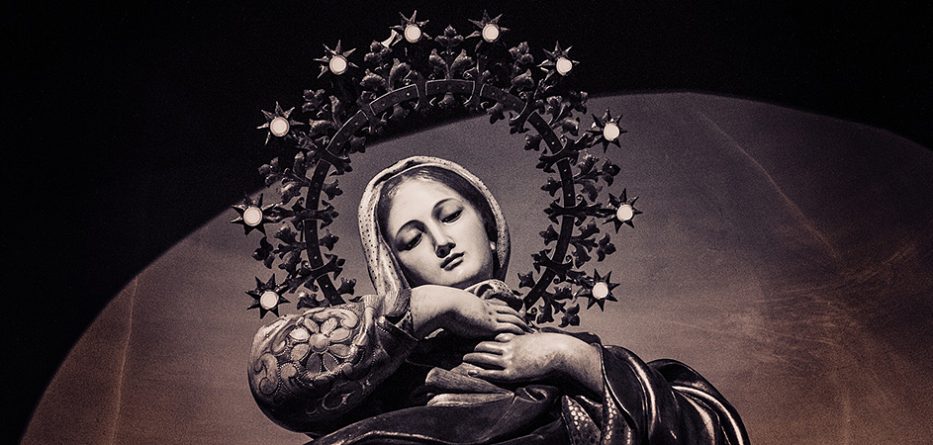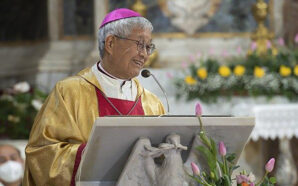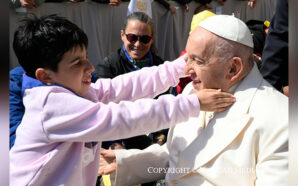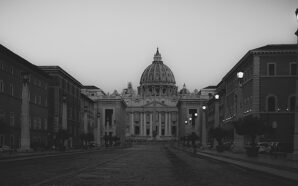When I was little, my uncle returned from an overseas trip with a gift from Lourdes: a Mary lamp. It took the shape of a grotto with Mary in the middle, clothed in a white-edged blue cloak. She had a slight tilt to her head and her arms were outstretched. When the lamp was plugged in, a circle of little lights surrounded her. She took up residence by my bed and I thought she was beautiful.
In Year 9 when we were reading the story of the Annunciation in Luke’s Gospel, the RE teacher delivered what I considered to be ground-breaking news: Mary probably didn’t wear a blue cloak. Not only that, Mary wasn’t Catholic. My head spun. I immediately thought of my Nana—this news would either bring on a nervous breakdown or a heart attack. I had heard Nana say on more than one occasion that Mary was far more important than Jesus (‘If it wasn’t for Mary there would be no Jesus’, she would pronounce). Nana had a Mary statue in every room of her house and Mary was cloaked in blue in every one of them. I think Nana probably could have dealt with the blue cloak issue—but I very much doubted she would manage the news that Mary was not Catholic.
And so began a journey of discovery for me about Miriam of Nazareth—this Jewish woman who has inspired strong Catholic devotion and sustained theological reflection about her virginity, her holiness and her role in the Church. What we know about Mary, the woman of faith, is pieced together from the Gospels. Our understanding of Mary in a historical context is formed from the knowledge we have about the place and role of women in first century Palestine. We know, for example, that girls were around 15 when they were betrothed (although some scholars argue Mary may have been as young as 12). From biblical texts we learn that Mary came from Nazareth (Luke 1:26) and, historically, we know that Nazareth was a relatively small agricultural town. This informs our understanding of her clothes—in keeping with rural life, Mary’s clothes would have been simple and probably more in earthy tones.
The Gospel of Luke provides the most enfleshed stories about Mary, and it is a Lukan image of Mary to which I always return: that of her pondering heart.
Early in Luke’s Gospel (chapter 2) we hear two references to the treasure of Mary’s heart: her son. Toward the end of the infancy narrative the angels have revealed to the shepherds the news of great joy that the Messiah has been born. The shepherds travel to Bethlehem and become messengers of the good news, and Mary ‘treasured all these words and pondered them in her heart’ (Luke 2:19–20). Later in Chapter 2 we hear the story of the boy Jesus in the Temple. For three days Mary and Joseph searched for their son and were greeted with Jesus asking why they looked for him: ‘Did you not know that I must be in my Father’s house? … His mother treasured all these things in her heart.’ (Luke 2: 49; 51)
Over the years I have often wondered about what dwelled in Mary’s heart. How must she have felt as such a young person when she discovered that she was pregnant? How must she have felt when she grew in understanding about Jesus and the path his life would take? How must she have felt as she stood at the foot of the cross? John O’Donohue in Benedictus describes the heart as the place where the ‘human spirit comes alive’. All of our burdens and joys are held there, and because the heart ‘dwells in unattended dark, we often forget its sublime sensitivity to everything that is happening to us. Without our ever noticing, the heart absorbs the joy of things and also their pain and care.’
I’m sure we’ve all had times when we have felt as though we are in the midst of a long and painful experience. Perhaps we have had a life upset, or a prolonged period of sadness, or are experiencing deep loss. These are the times when even the days seem dark—when our hearts are working hard to make sense of what is going on and we wonder if the heaviness will ever lift. Sometimes the movement towards a lighter heart is so gradual that we don’t even realise the darkness is lifting. Perhaps we saw the humour in something and felt our spirit was a little lighter; perhaps it was realising that for the first time in a long while the day has slipped by without tears coming unbidden or without thoughts of a loved one who has died. This is the slow, careful work of the heart, moving us from darkness into light—a different light, but light nonetheless.
Prayerful people may understand this as the work of an in-dwelling God—the God of the heart always present, moving us gently from darkness to light; journeying with us through all the little deaths and resurrections of the day and the larger deaths and resurrections of life. A daily reminder to us of the paschal mystery at work in our lives and the world.
And this is why I think about Mary’s heart. Everything we learn about Mary reminds us that she was working with a heart that was always oriented towards God; that her daily lived response was a response to God. Her joys and sorrows, her living and loving were always animated by God. Her every action was a proclamation of the love of God.
Over the years many theologians have reflected on Mary and her role in the Church. Their reflections have led to doctrinal pronouncements and also feast days, the most significant of which is the Feast of the Assumption. So important is this feast in the life of the Church that it is a holy day of obligation (Christmas Day being the other holy day of obligation in Australia). The dogma of Mary’s Assumption was promulgated in 1950 by Pope Pius XII. In essence, this dogma reminds us that Mary was full of grace and as such was assumed into heaven to be with her son and her God.
So perhaps on 15 August, when we celebrate the Feast of the Assumption, we will remember this woman whose heart was with God; this young girl who accepted God’s gracious invitation to be the mother of Jesus—the theotokos (God-bearer)—and whose every action is a proclamation of the goodness of God.
And my Mary lamp—well, it is long gone. But it illuminated the first steps of my Mary journey towards understanding a little more about her beloved son Jesus, and awakened my heart to recognising the graciousness of God at work in my own life.
Song of Mary (the Magnificat)
My soul proclaims the greatness of God,
my spirit rejoices in God my Saviour;
for he has looked in favour on his lowly servant,
and from this day all generations will call me blessed;
the Almighty has done great things for me:
holy is his name.
He has mercy on those who fear him from
generation to generation.
He has shown the strength of his arm,
he has scattered the proud in their conceit.
He has put down the mighty from their thrones,
and has lifted up the lowly.
He has filled the hungry with good things,
and the rich he has sent away empty.
He has come to the help of his servant Israel
for he has remembered his promise of mercy,
the promise he made to our fathers,
to Abraham and to his children forever.
Cathy Jenkins is the Director of the Archbishop’s Office for Evangelisation.
This article was originally published in the August 2019 edition of the Melbourne Catholic Magazine.
With thanks to Melbourne Catholic Magazine and the Archdiocese of Melbourne.








